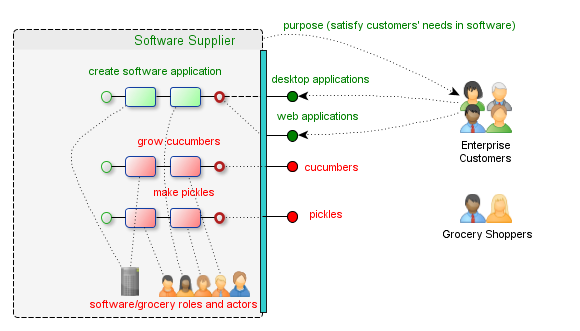Effectiveness vs. Efficiency vs. Efficacy
Effectiveness means doing the right things. Applied to an organization or an organizational unit, it means that the organization should have the right purpose supported by the right function, which in turn is supported by the right behavior performed by the right actors.
The right purpose means that the organization has the right reason for existence, plays the right role in the environment, and connects to the right customers. The right function means that the organization supplies the right products, provides the right services, and offers the right self-service interfaces that support that purpose. The right behavior means that the organization runs the right business processes to support its functions. The right structure means that the organization has the right actors who are capable of playing the right roles.
Figure 1. Ineffective software supplier organization
Efficiency means doing things right—on time, on spec, and on budget.
In The Cult of Efficiency, Janice Gross Stein tells us that efficiency is not an end, but a means to achieve valued ends
.
From time to time, executives around the world conduct aggressive efficiency campaigns, often out of desperation or due to a general lack of interesting ideas.
The efficiency campaigns should be preceded or accompanied by organizational effectiveness programs.
No matter how efficient the Build Nuclear Reactor business process is, the fact is that it is disconnected not only from the organization's purpose, but also from its function (Figure 2).

In General Systems Theory, Lars Skyttner defines efficacy as a measure of the extent to which the system contributes to the purposes of a higher-level system of which it may be a subsystem
.
W. Edwards Deming uses the London Philharmonic Orchestra as an example that illustrates how parts of an organization contribute their best to the whole:
An example of a system, well optimized, is a good orchestra. The players are not there to play solos as prima donnas, each one trying to catch the ear of the listener. They are there to support each other. Individually, they need not be the best players in the country.
Thus, each of the 140 players in the Royal Philharmonic Orchestra of London is there to support the other 139 players. An orchestra is judged by listeners, not so much by illustrious players, but by the way they work together. The conductor, as manager, begets cooperation between the players, as a system, every player to support the others. There are other aims for an orchestra, such as joy in work for the players and for the conductor.
The obligation of any component is to contribute its best to the system, not to maximize its own production, profit, or sales, nor any other competitive measure. Some components may operate at a loss to themselves in order to optimize the whole system, including the components that take the loss.
Key Points
UOA creates digital constructs that provide interactional and operational support to organizational units. An organizational unit is a social system, which represents a social technology phenomenon programmed to some purpose(s).
UOA views the organization as an implementation of the Composite design pattern with every node treated either as a Composite (control unit) or a Leaf (functional unit).
Unit software must be as comfortable to an organizational unit as a house is to a family, a space station to an astronaut crew, or a battle tank to a fighting crew.
Each unit must have a formal [software] boundary, which represents a contract between the unit and other entities inside and outside of the organization.
Each unit runs its own operations implemented as executable business processes. Every process in the organization is owned by exactly one unit. A unit might engage another unit or organization to perform a task within the context of the process it owns.
UOA places a special emphasis on control units, which today often consist of just one or a few people, have inadequate information support, and, therefore, have become the weakest links in modern organizations.
UOA uses Systems Thinking for defining the problem, Organization Design for configuring both an enterprise and a composite unit, SOA for constructing unit boundaries, EDA for inter-unit communication, BPM for defining unit operations, and Business Rules for governance.